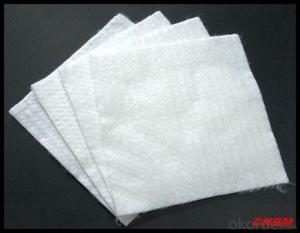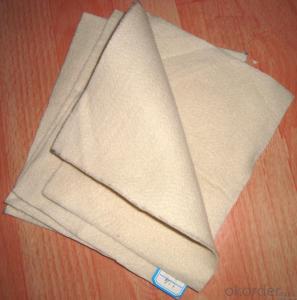Geotextile Fibre Filament Spunbond Geotextile Fabric for Road Construction - China
- Loading Port:
- China main port
- Payment Terms:
- TT OR LC
- Min Order Qty:
- 2000 m²
- Supply Capability:
- 10000000 m²/month
OKorder Service Pledge
OKorder Financial Service
You Might Also Like
Specification
Filament Spunbond Nonwoven Geotextile Description:
Made from virgin PET(polyester)chips,the continuous filament was extruded from
PET chip by machine directly by spunbond process,and then punch together to
get the stable 3D with higher strength fabric.So it has high strength, good creep
property excellent and erosion resistance,aging-resistance and heat resistance.
Filament Spunbond Nonwoven Geotextile Property:
Good creep property and hydraulics property,resistance to corrosion,
excellent anti-aging and heat-resistance quality.
Filament Spunbond Nonwoven Geotextile Application:
1.filtration of soils in drainage application by retaining soil particles
while allowing for the free flow of water
2.Separation and reinforcement in road and railway construction
3.Prevention of soil movement in erosion control measures
4.Cushioning and protection in many containment projects
1 grams of weight range: 10 ~ 250g/ square meters;
2 the maximum width: 1.6 meters (according to the customer request length processing)
3 color: can be produced according to customer requirements


Our Service
Quality assurance
1.On a regular basis or as per your request,we entrust national testing agencies to conduct quality inspections
2. Strictly in accordance with the ISO9001-2008 international quality system standard,we monitor and manage the whole process throughout production,quality testing,and measurement to ensure product quality
3. For quality-related construction delay or substandard construction(except for damage or losses due to customer’s responsibility or irresistible natural disasters),we have refunding,replacement,and repair services.We will respond to customers’ feedbacks on quality issues within 24 hours.
Q: What kind of payments does jenor support?
A: T/T, L/C, Cash are accepted.
Q: Do you charge for the samples?
A: Accordeing to our company policy, the samples are free, we only charge the freight fee. And we will return the freight fee during the next order.
Q: Can you produce according to customers' design?
A: Sure, we are professional manufacturer, OEM and ODM are both welcome.
Q: Do you have other products?
A: Yes, please check the pictures:
Packaging & Shipping
Packing: PLASTIC FILM INSIDE, AND WOVEN BAG OUTSIDE
Shipping: About 15 days after receipt the deposit
- Q: How do geotextiles help with erosion control on slopes?
- Geotextiles provide erosion control on slopes by acting as a barrier that prevents soil erosion caused by wind and water. These textiles are permeable, allowing water to pass through while trapping soil particles, thereby stabilizing the slope and preventing erosion. Additionally, geotextiles enhance vegetation growth by retaining moisture and providing a protective layer, further reducing erosion on slopes.
- Q: what is the purpose of geotextile on gabion walls.?
- Geotextiles are fabrics associated with soil, earth or rocks. Gabions were earth filled barricades meant to halt enemy fire during battle. I'm guessing geotextiles on gabion walls more effectively hold back the earth or filler. They might have well suited permeability or retentive qualities for gabions. There are a few other definitions for gabions. But this is the militaristic definition. Gabions are also used in dams and such. In this case, geotxtiles might have good properties for being submerged in water and still retaining whats inside the gabions.
- Q: What are the advantages of using geotextiles in landfill lining systems?
- There are several advantages of using geotextiles in landfill lining systems. Firstly, geotextiles act as a barrier, preventing the leakage and migration of hazardous substances from the landfill into the surrounding environment, thus protecting groundwater and adjacent ecosystems. Secondly, geotextiles enhance the stability and integrity of the landfill by providing reinforcement and preventing soil erosion, which can lead to slope failure and instability. Additionally, geotextiles offer excellent filtration properties, allowing for the efficient drainage of liquids within the landfill, reducing the buildup of pore pressure, and improving the overall performance of the system. Lastly, geotextiles are durable, resistant to chemical degradation, and have a long lifespan, making them a cost-effective and sustainable solution for landfill lining systems.
- Q: Are geotextiles suitable for use in geotextile tube dewatering systems?
- Yes, geotextiles are suitable for use in geotextile tube dewatering systems. Geotextiles are designed to provide filtration, separation, and reinforcement functions, making them ideal for use in dewatering systems that require the removal of water from sediments or sludge. The permeable nature of geotextiles allows water to pass through while retaining solids, ensuring efficient dewatering and sediment containment.
- Q: Can geotextiles be used in retaining wall drainage systems?
- Yes, geotextiles can be used in retaining wall drainage systems. Geotextiles are commonly used as a filter fabric to prevent the migration of fine particles into the drainage system, while allowing water to flow through. By placing geotextiles behind the retaining wall, they help to enhance the drainage efficiency and overall stability of the system.
- Q: Geotextile how the weight of how many meters
- Cut with a pair of scissors 1 square meters, and then weighed, the total weight ÷ weight per square meter ÷ geotextile width = length meter (because the weight of geotextile deviation, the calculation results can only be roughly the same, not subject)
- Q: How are geotextiles used in landfill construction?
- Geotextiles are used in landfill construction to provide reinforcement, separation, and filtration functions. They are placed between the layers of soil and waste materials to help prevent soil erosion, enhance the stability of the landfill, and prevent the mixing of different soil layers. Additionally, geotextiles act as a filter to allow the passage of water while preventing the migration of fine particles, thus reducing the risk of contamination.
- Q: How do geotextiles compare to traditional construction materials?
- Geotextiles offer several advantages over traditional construction materials. Firstly, geotextiles are lightweight and easy to handle, making them more convenient to transport and install. Secondly, they have excellent filtration properties, allowing for effective drainage and preventing soil erosion. Additionally, geotextiles are highly durable, resistant to rot and chemicals, and can withstand harsh environmental conditions. They are also relatively cost-effective compared to traditional materials, reducing project expenses. Overall, geotextiles provide a versatile and efficient solution for various construction applications.
- Q: How about the geotextile pond
- You said to cover the fish pond, I understand is to build the bottom of the fish pond, but the use is not geotextile, but the composite geomembrane, the film is generally two layers of geotextile in the middle of a layer of geomembrane, , And geomembrane on both sides of the geotextile can prevent the bottom of the sharp objects pierced the geomembrane.
- Q: How are geotextiles used in sports field construction?
- Geotextiles are used in sports field construction to enhance the stability, drainage, and longevity of the playing surface. They are commonly installed beneath the turf to provide separation between the subbase and the playing surface, preventing the migration of fines and ensuring proper filtration of water. Geotextiles also help to distribute loads evenly, reduce soil compaction, and prevent the formation of ruts and depressions on the field. Overall, geotextiles play a crucial role in creating high-performance and durable sports fields.
Send your message to us
Geotextile Fibre Filament Spunbond Geotextile Fabric for Road Construction - China
- Loading Port:
- China main port
- Payment Terms:
- TT OR LC
- Min Order Qty:
- 2000 m²
- Supply Capability:
- 10000000 m²/month
OKorder Service Pledge
OKorder Financial Service
Similar products
Hot products
Hot Searches
Related keywords
































